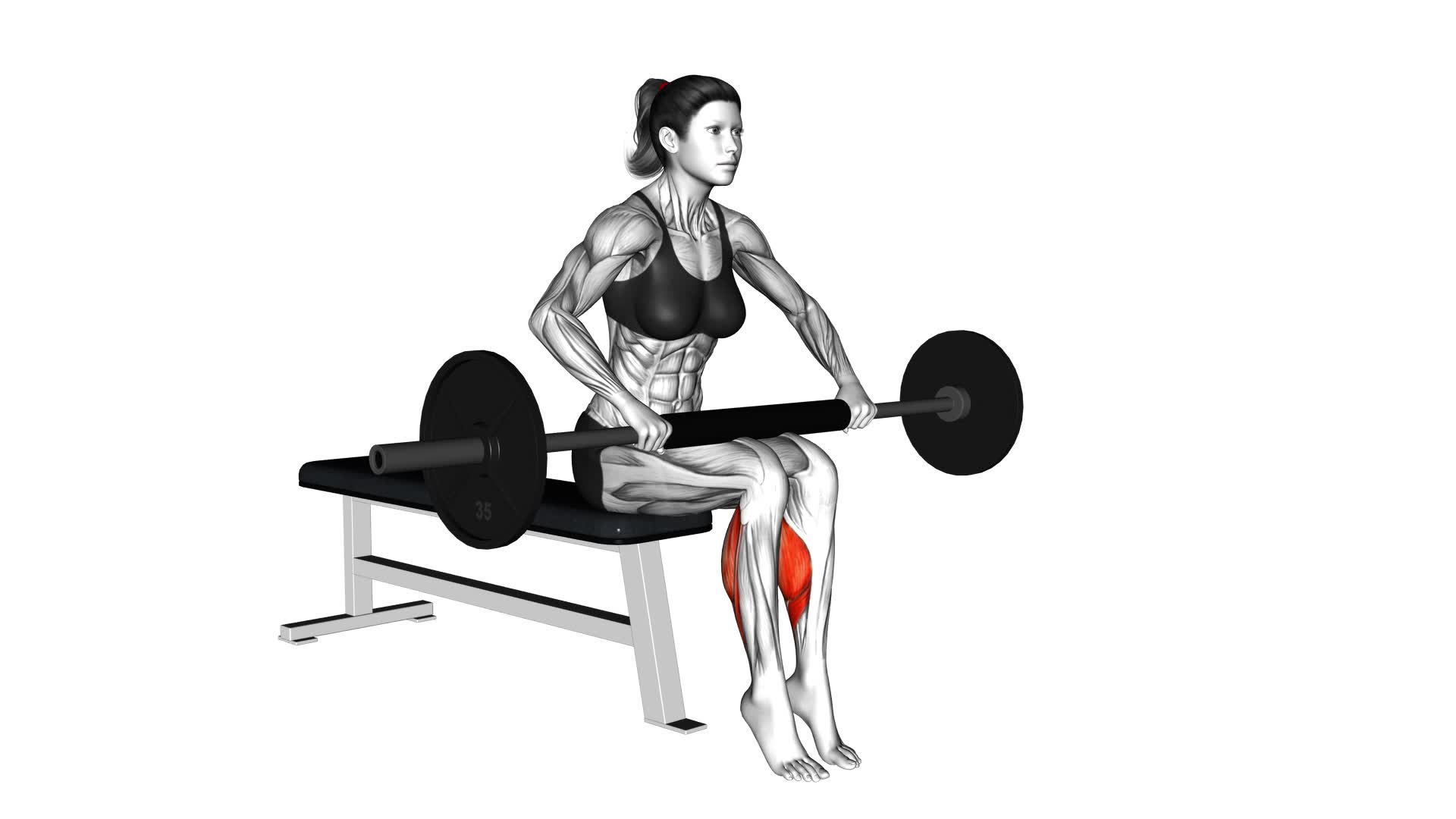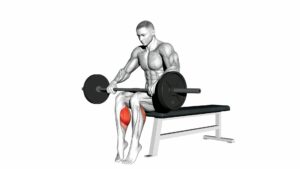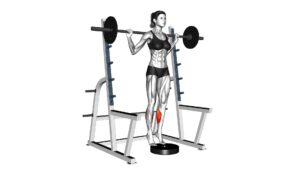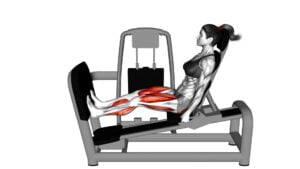Barbell Seated Calf Raise (female) – Video Exercise Guide & Tips

Are you looking to strengthen and tone your calf muscles?
Watch This Exercise Video
The barbell seated calf raise is a fantastic exercise for you. In this video exercise guide, we will walk you through the proper form and technique, as well as provide helpful tips for maximizing your results.
With variations and modifications available, this exercise can be tailored to your fitness level.
Get ready to feel the burn and achieve those strong, sculpted calves!
Key Takeaways
- Targets the soleus muscle for improved ankle stability and prevention of injuries
- Enhances lower leg strength and stability
- Helps prevent injuries such as sprained ankles and calf strains
- Use appropriate equipment such as a bench, barbell, and platform for feet
Benefits of the Barbell Seated Calf Raise
To maximize the effectiveness of your calf workout, consider incorporating the barbell seated calf raise into your routine. This exercise offers numerous benefits, including improved ankle stability and strengthened lower leg muscles.
The barbell seated calf raise specifically targets the soleus muscle, which is the smaller muscle located underneath the gastrocnemius muscle in your calf. By strengthening this muscle, you can enhance ankle stability and prevent injuries related to weak lower leg muscles.
When performing the barbell seated calf raise, you sit on a bench and place a barbell across your upper thighs. With your feet resting on a platform, you raise your heels as high as possible, contracting your calf muscles. This exercise allows you to use heavier weights compared to standing calf raises, increasing the intensity and effectiveness of your calf workout.
By incorporating the barbell seated calf raise into your routine, you can improve ankle stability, which is crucial for activities that involve running, jumping, and changing directions. Additionally, strengthening your lower leg muscles can help prevent injuries, such as sprained ankles and calf strains.
Add this exercise to your calf workout for optimal results in developing strong and stable lower legs.
Proper Form and Technique
When performing the barbell seated calf raise, sit on a bench with a barbell placed across your upper thighs, and keep your feet resting on a platform. This exercise primarily targets the calf muscles and can help improve lower leg strength and stability.
To ensure proper form and technique, here are some key points to keep in mind:
- Maintain proper posture: Sit up straight with your core engaged and shoulders pulled back. This helps to align your spine and prevent any unnecessary strain on your back.
- Start with a comfortable weight: Begin with a weight that allows you to perform the exercise with proper form. Gradually increase the weight as your strength improves.
- Use a full range of motion: Lower your heels as far as possible, feeling a stretch in your calves, and then raise your heels as high as you can, squeezing your calves at the top of the movement.
- Avoid bouncing or jerking motions: Control the movement throughout the exercise and avoid any sudden or jerky movements that can lead to injury.
Equipment needed for the barbell seated calf raise includes a bench, a barbell, and a platform for your feet. It's important to choose the appropriate weight and maintain proper form to maximize the benefits and prevent common mistakes that can hinder your progress.
Variations and Modifications
Try incorporating different variations and modifications into your barbell seated calf raise routine to target your calf muscles in new and challenging ways. By adding seated calf raise variations, you can effectively stimulate different parts of your calves and prevent muscle adaptation.
One variation you can try is the single-leg seated calf raise. Instead of using both legs, focus on one leg at a time. This will increase the intensity and provide a greater challenge to your calf muscles.
Another variation is the seated calf raise with a resistance band. Wrap a resistance band around the balls of your feet and hold the ends with your hands. As you perform the exercise, the resistance band will add extra tension, making it more difficult to complete the movement.
Additionally, you can modify the seated calf raise exercise by using dumbbells instead of a barbell. This will require more stabilization from your core and increase the difficulty of the exercise.
Remember to start with lighter weights and gradually increase as you become stronger and more comfortable with the modifications. Incorporating these seated calf raise variations and modified exercises will help you continually challenge your calf muscles and achieve better results.
Tips for Maximizing Results
To optimize your results, focus on consistency and progression in your barbell seated calf raise routine. Here are some tips to help you maximize your gains:
- Common Mistakes
- Avoid bouncing at the bottom of the movement, as it reduces the effectiveness and can lead to injury.
- Instead, maintain control throughout the entire range of motion.
- Don't use excessive weight that compromises your form.
- It's better to start with a lighter load and gradually increase as you become stronger and more comfortable with the exercise.
- Recommended Footwear
- Choose footwear that provides stability and support.
- Opt for shoes with a firm sole and a snug fit to ensure proper foot positioning and prevent slipping.
- Consider using weightlifting shoes, which have a raised heel that can improve ankle mobility and allow for a deeper calf stretch during the exercise.
Sample Workout Routine
For a sample workout routine, you can incorporate the barbell seated calf raise into your leg day exercises. This exercise specifically targets the calf muscles and can be a great addition to your workout routine, especially if you're looking to strengthen and tone your calves.
To begin, sit on a flat bench with your feet positioned on the platform of the calf raise machine, and place the barbell across your upper thighs. Make sure your toes are pointing forward and your knees are slightly bent. This is your starting position.
To perform the exercise, push down with your toes, raising your heels off the platform. Hold the contraction for a second at the top, and then slowly lower your heels back down to the starting position. Remember to keep your core engaged and maintain control throughout the movement.
You can incorporate the barbell seated calf raise into your leg day workout by performing 3 sets of 10-12 repetitions. It's important to use a weight that challenges you, but allows you to maintain proper form. As with any exercise, it's also recommended to consult with a fitness professional before starting a new workout routine.
Frequently Asked Questions
How Much Weight Should I Use for the Barbell Seated Calf Raise?
To determine the weight for the barbell seated calf raise, start with a moderate amount that challenges your calf muscles. As you become more comfortable, gradually increase the weight.
This exercise targets your calf muscles, helping to strengthen and tone them. Barbell seated calf raises can be done with variations like using different foot positions or a single leg.
Incorporating this exercise into your routine can provide several benefits for your lower legs.
Can I Perform the Barbell Seated Calf Raise Without a Barbell?
Yes, you can perform the barbell seated calf raise without a barbell. There are alternative exercises that you can do without any equipment to target your calf muscles. These exercises include standing calf raises, toe raises, and jumping rope.
Not only do these exercises help strengthen your calf muscles, but they also improve ankle mobility. So, even without a barbell, you can still benefit from ankle mobility exercises.
Are There Any Alternative Exercises That Target the Calf Muscles?
Looking for alternative exercises to target your calf muscles? There are plenty of options to choose from! Strengthening your calves not only improves your athletic performance but also helps with balance and stability.
Consider trying exercises like standing calf raises, calf raises on a leg press machine, or even skipping rope. These exercises provide similar benefits as the barbell seated calf raise and can be easily incorporated into your workout routine.
How Often Should I Include the Barbell Seated Calf Raise in My Workout Routine?
Including the barbell seated calf raise in your workout routine has many benefits. It targets your calf muscles, helping to strengthen and tone them. To properly perform this exercise, sit on a bench with a barbell resting on your thighs. Place the balls of your feet on a raised platform, then lift your heels as high as possible. Aim to include the barbell seated calf raise in your routine 2-3 times per week for optimal results.
Can the Barbell Seated Calf Raise Help With Improving Ankle Mobility?
Improving ankle mobility is crucial for your balance and overall fitness goals. The barbell seated calf raise exercise can be a great addition to help with this. By targeting the calves and ankles, it strengthens the muscles and increases flexibility, leading to improved ankle mobility.
This exercise provides numerous benefits, such as better stability, reduced risk of injury, and enhanced performance in other activities. So, incorporating the barbell seated calf raise into your routine can definitely improve your ankle mobility.
Conclusion
In conclusion, the barbell seated calf raise is a highly effective exercise for building strong and defined calf muscles. By maintaining proper form and technique, varying the weight and foot placement, and incorporating it into a well-rounded workout routine, you can maximize your results and achieve your fitness goals.
Remember to consult with a fitness professional if you have any concerns or questions about incorporating this exercise into your routine.

Author
Years ago, the spark of my life’s passion ignited in my mind the moment I stepped into the local gym for the first time. The inaugural bead of perspiration, the initial endeavor, the very first surge of endorphins, and a sense of pride that washed over me post-workout marked the beginning of my deep-seated interest in strength sports, fitness, and sports nutrition. This very curiosity blossomed rapidly into a profound fascination, propelling me to earn a Master’s degree in Physical Education from the Academy of Physical Education in Krakow, followed by a Sports Manager diploma from the Jagiellonian University. My journey of growth led me to gain more specialized qualifications, such as being a certified personal trainer with a focus on sports dietetics, a lifeguard, and an instructor for wellness and corrective gymnastics. Theoretical knowledge paired seamlessly with practical experience, reinforcing my belief that the transformation of individuals under my guidance was also a reflection of my personal growth. This belief holds true even today. Each day, I strive to push the boundaries and explore new realms. These realms gently elevate me to greater heights. The unique combination of passion for my field and the continuous quest for growth fuels my drive to break new ground.







